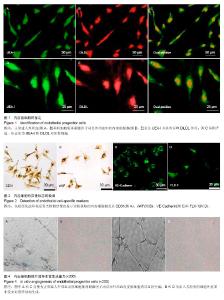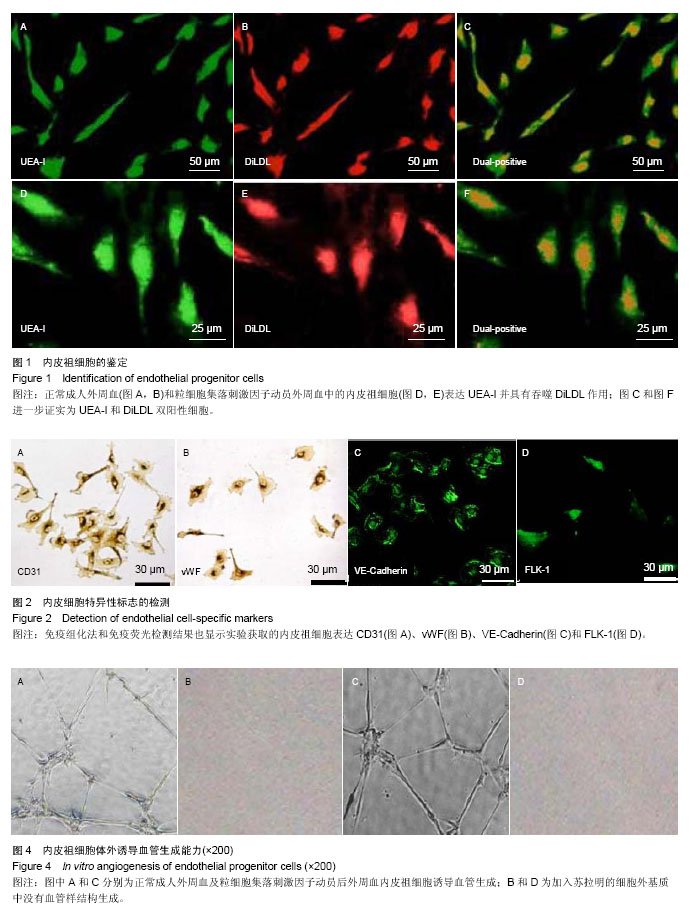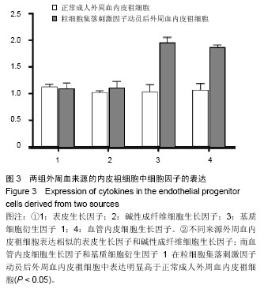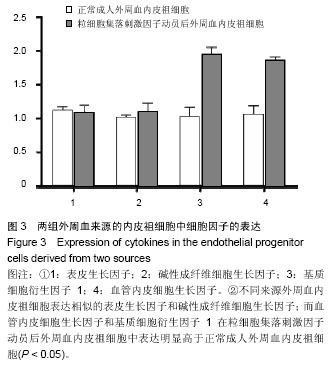Chinese Journal of Tissue Engineering Research ›› 2014, Vol. 18 ›› Issue (32): 5190-5196.doi: 10.3969/j.issn.2095-4344.2014.32.018
Previous Articles Next Articles
Biological characteristics of endothelial progenitor cells derived from granulocyte colony-stimulating factor mobilized peripheral blood
Bai Li-ping1, Zhao Zhi-hong1, Chen Chong1, Wang Jin-huan2, Wang Zhen-ling2, Zhao Zhi-gang2
- 1Department of Laboratory, Tianjin Medical University Cancer Institute and Hospital, National Clinical Research Center for Cancer, Key Laboratory of Cancer Prevention and Therapy, Tianjin 300060, China; 2Department of Hematology and Oncology, Tianjin Medical University Cancer Institute and Hospital, Tianjin 300060, China
-
Received:2014-07-17Online:2014-08-06Published:2014-09-18 -
Contact:Bai Li-ping, Department of Laboratory, Tianjin Medical University Cancer Institute and Hospital, National Clinical Research Center for Cancer, Key Laboratory of Cancer Prevention and Therapy, Tianjin 300060, China -
About author:Bai Li-ping, Associate chief technician, Department of Laboratory, Tianjin Medical University Cancer Institute and Hospital, National Clinical Research Center for Cancer, Key Laboratory of Cancer Prevention and Therapy, Tianjin 300060, China -
Supported by:the National Natural Science Foundation of China, No. 81172833
CLC Number:
Cite this article
Bai Li-ping, Zhao Zhi-hong, Chen Chong, Wang Jin-huan, Wang Zhen-ling, Zhao Zhi-gang. Biological characteristics of endothelial progenitor cells derived from granulocyte colony-stimulating factor mobilized peripheral blood[J]. Chinese Journal of Tissue Engineering Research, 2014, 18(32): 5190-5196.
share this article

2.1 内皮祖细胞的鉴定和形态学特点 于倒置显微镜下观察,原代培养的贴壁细胞形态表现为梭形或多边形,胞浆丰富,核仁明显,呈不规则排列生长。传代后细胞形态不发生改变,当细胞融合后呈“铺路卵石样”。通过共聚焦显微镜观察,UEA-Ⅰ和DiLDL双染色阳性的细胞被认为是正在分化的内皮祖细胞,实验从粒细胞集落刺激因子动员的外周血和对照组(正常成人外周血)中都培养出内皮祖细胞(图1)。 通过对原代培养细胞的计数结果显示粒细胞集落刺激因子动员的外周血中内皮祖细胞的数量[(102.0±2.6)/视野(×200)]明显高于正常成人外周血中的内皮祖细胞[(59.0± 5.1)/视野(×200),P < 0.01]。 粒细胞集落刺激因子动员的外周血中获取的内皮祖细胞可以在体外稳定培养6-8代,随后细胞增殖减慢,细胞形态变大,胞浆中颗粒增多,呈现老化状态;而正常成人外周血中的内皮祖细胞最多在体外培养5代,然后细胞呈现老化状态。 2.2 内皮祖细胞的免疫表型 通过流式细胞仪检测内皮祖细胞的免疫表型,发现原代获取的内皮祖细胞表达CD31、FLK-1、VE-Cadherin、vWF和CD133。随着细胞传代,CD31和vWF的表达逐渐增加,而CD133的表达下降,从第3代起,已经检测不出CD133的表达。免疫组化法检测结果也显示获取的内皮祖细胞表达CD31、FLK-1、VE-Cadherin和vWF(图2)。 粒细胞集落刺激因子动员的外周血和对照组(正常成人外周血)中获取的内皮祖细胞具有相似的免疫表型。 2.3 内皮祖细胞的增殖和黏附能力 采用MTT比色法检测了不同来源外周血内皮祖细胞的增殖能力,结果显示粒细胞集落刺激因子动员的外周血中获取的内皮祖细胞增殖能力明显强于正常成人外周血内皮祖细胞的增殖能力(0.84±0.03 vs. 0.47±0.04,P < 0.05)。 另外,还检测了不同来源外周血内皮祖细胞的黏附能力,结果显示粒细胞集落刺激因子动员的外周血中获取的内皮祖细胞,与正常成人外周血内皮祖细胞具有相似的黏附能力[(96.32±5.61)/视野(×200) vs. (104.12±2.68)/视野(×200),P > 0.05]。"

| [1] Asahara T, Kawamoto A, Masuda H.Concise review: Circulating endothelial progenitor cells for vascular medicine.Stem Cells. 2011;29(11):1650-1655. [2] Fadini GP, Agostini C, Avogaro A. Autologous stem cell therapy for peripheral arterial disease meta-analysis and systematic review of the literature.Atherosclerosis. 2010; 209(1):10-17. [3] Chavakis E, Koyanagi M, Dimmeler S.Enhancing the outcome of cell therapy for cardiac repair: progress from bench to bedside and back.Circulation. 2010;121(2):325-335. [4] Ahrens I, Domeij H, Topcic D,et al.Successful in vitro expansion and differentiation of cord blood derived CD34+ cells into early endothelial progenitor cells reveals highly differential gene expression.PLoS One. 2011;6(8):e23210. [5] Chen JY, Feng L, Zhang HL,et al. Differential regulation of bone marrow-derived endothelial progenitor cells and endothelial outgrowth cells by the Notch signaling pathway. PLoS One. 2012;7(10):e43643. [6] Zhao Y, Glesne D, Huberman E.A human peripheral blood monocyte-derived subset acts as pluripotent stem cells.Proc Natl Acad Sci U S A. 2003;100(5):2426-2431. [7] Kalka C, Masuda H, Takahashi T,et al.Transplantation of ex vivo expanded endothelial progenitor cells for therapeutic neovascularization.Proc Natl Acad Sci U S A. 2000;97(7): 3422-3427. [8] Quirici N, Soligo D, Caneva L,et al.Differentiation and expansion of endothelial cells from human bone marrow CD133(+) cells.Br J Haematol. 2001;115(1):186-194. [9] Kaushal S, Amiel GE, Guleserian KJ,et al. Functional small-diameter neovessels created using endothelial progenitor cells expanded ex vivo.Nat Med. 2001;7(9): 1035-1040. [10] Harraz M, Jiao C, Hanlon HD,et al. CD34- blood-derived human endothelial cell progenitors.Stem Cells. 2001;19(4): 304-312. [11] Kida Y, Ieronimakis N, Schrimpf C,et al. EphrinB2 reverse signaling protects against capillary rarefaction and fibrosis after kidney injury.J Am Soc Nephrol. 2013;24(4):559-572. [12] Vasa M, Fichtlscherer S, Adler K,et al. Increase in circulating endothelial progenitor cells by statin therapy in patients with stable coronary artery disease.Circulation. 2001;103(24): 2885-2890. [13] Llevadot J, Murasawa S, Kureishi Y,et al. HMG-CoA reductase inhibitor mobilizes bone marrow--derived endothelial progenitor cells.J Clin Invest. 2001;108(3): 399-405. [14] Asahara T, Murohara T, Sullivan A,et al. Isolation of putative progenitor endothelial cells for angiogenesis.Science. 1997; 275(5302):964-967. [15] Asahara T, Masuda H, Takahashi T,et al. Bone marrow origin of endothelial progenitor cells responsible for postnatal vasculogenesis in physiological and pathological neovascularization.Circ Res. 1999;85(3):221-228. [16] Gehling UM, Ergün S, Schumacher U,et al. In vitro differentiation of endothelial cells from AC133-positive progenitor cells.Blood. 2000;95(10):3106-3112. [17] Michaelis LC, Hamadani M, Hari PN. Hematopoietic stem cell transplantation in older persons: respecting the heterogeneity of age. Expert Rev Hematol. 2014;7(3):321-324. [18] Chen YS, Kong XJ, Zhang XH,et al.Treatment of acute mixed-cell leukemia with autologous hematopoietic SCT followed by allogeneic hematopoietic stem cell micro- transplantation.Bone Marrow Transplant. 2014;49(7):984- 985. [19] Schnetzke U, Fix P, Spies-Weisshart B, et al. Efficacy and feasibility of cyclophosphamide combined with intermediate- dose or high-dose cytarabine for relapsed and refractory acute myeloid leukemia (AML).J Cancer Res Clin Oncol. 2014;140(8):1391-1397. [20] Fathi AT, Chen YB.Treatment of relapse of acute myeloid leukemia after allogeneic hematopoietic stem cell transplantation. Curr Hematol Malig Rep. 2014;9(2):186-192. [21] Gehling UM, Ergün S, Schumacher U,et al. In vitro differentiation of endothelial cells from AC133-positive progenitor cells.Blood. 2000;95(10):3106-3112. [22] Takahashi T, Kalka C, Masuda H,et al. Ischemia- and cytokine-induced mobilization of bone marrow-derived endothelial progenitor cells for neovascularization.Nat Med. 1999;5(4):434-438. [23] Young PE, Baumhueter S, Lasky LA.The sialomucin CD34 is expressed on hematopoietic cells and blood vessels during murine development.Blood. 1995;85(1):96-105. [24] Fina L, Molgaard HV, Robertson D,et al.Expression of the CD34 gene in vascular endothelial cells.Blood. 1990;75(12): 2417-2426. [25] Baumhueter S, Dybdal N, Kyle C,et al. Global vascular expression of murine CD34, a sialomucin-like endothelial ligand for L-selectin.Blood. 1994;84(8):2554-2565. [26] Yamaguchi TP, Dumont DJ, Conlon RA,et al.flk-1, an flt-related receptor tyrosine kinase is an early marker for endothelial cell precursors.Development. 1993;118(2):489- 498. [27] Eichmann A, Corbel C, Nataf V,et al. Ligand-dependent development of the endothelial and hemopoietic lineages from embryonic mesodermal cells expressing vascular endothelial growth factor receptor 2. Proc Natl Acad Sci U S A. 1997;94(10):5141-5146. [28] Shalaby F, Ho J, Stanford WL,et al. A requirement for Flk1 in primitive and definitive hematopoiesis and vasculogenesis. Cell. 1997;89(6):981-990. [29] Flamme I, Breier G, Risau W.Vascular endothelial growth factor (VEGF) and VEGF receptor 2 (flk-1) are expressed during vasculogenesis and vascular differentiation in the quail embryo.Dev Biol. 1995;169(2):699-712. [30] Quirici N, Soligo D, Caneva L,et al. Differentiation and expansion of endothelial cells from human bone marrow CD133(+) cells.Br J Haematol. 2001;115(1):186-194. [31] Schmeisser A, Strasser RH. Phenotypic overlap between hematopoietic cells with suggested angioblastic potential and vascular endothelial cells.J Hematother Stem Cell Res. 2002; 11(1):69-79. [32] Rehman J, Li J, Orschell CM,et al. Peripheral blood "endothelial progenitor cells" are derived from monocyte/macrophages and secrete angiogenic growth factors. Circulation. 2003;107(8):1164-1169. [33] Kohler EE, Wary KK, Li F,et al. Flk1+ and VE-cadherin+ endothelial cells derived from iPSCs recapitulates vascular development during differentiation and display similar angiogenic potential as ESC-derived cells.PLoS One. 2013; 8(12):e85549. [34] Yin L, Ohanyan V, Pung YF,et al. Induction of vascular progenitor cells from endothelial cells stimulates coronary collateral growth.Circ Res. 2012;110(2):241-252. [35] Ha X, Zhao M, Zhao H,et al. Identification and clinical significance of circulating endothelial progenitor cells in gastric cancer.Biomarkers. 2013;18(6):487-492. [36] Wara AK, Croce K, Foo S,et al. Bone marrow-derived CMPs and GMPs represent highly functional proangiogenic cells: implications for ischemic cardiovascular disease.Blood. 2011; 118(24):6461-6464. [37] Thal MA, Krishnamurthy P, Mackie AR,et al. Enhanced angiogenic and cardiomyocyte differentiation capacity of epigenetically reprogrammed mouse and human endothelial progenitor cells augments their efficacy for ischemic myocardial repair.Circ Res. 2012;111(2):180-190. |
| [1] | Ou Hangjun, Zhao Guangjian, Pan Yujia, Gong Caiwei, Zhao Quanwei, Liu Danan. Construction of a lentiviral vector overexpressing fibronectin type III domain containing 5 to inhibit apoptosis of endothelial cells [J]. Chinese Journal of Tissue Engineering Research, 2023, 27(2): 216-222. |
| [2] | Zhang Lichuang, Xu Hao, Ma Yinghui, Xiong Mengting, Han Haihui, Bao Jiamin, Zhai Weitao, Liang Qianqian. Mechanism and prospects of regulating lymphatic reflux function in the treatment of rheumatoid arthritis [J]. Chinese Journal of Tissue Engineering Research, 2022, 26(9): 1459-1466. |
| [3] | Zhu Bingbing, Deng Jianghua, Chen Jingjing, Mu Xiaoling. Interleukin-8 receptor enhances the migration and adhesion of umbilical cord mesenchymal stem cells to injured endothelium [J]. Chinese Journal of Tissue Engineering Research, 2022, 26(7): 1045-1050. |
| [4] | Zhang Yujie, Yang Jiandong, Cai Jun, Zhu Shoulei, Tian Yuan. Mechanism by which allicin inhibits proliferation and promotes apoptosis of rat vascular endothelial cells [J]. Chinese Journal of Tissue Engineering Research, 2022, 26(7): 1080-1084. |
| [5] | Yin Tingting, Du Dayong, Jiang Zhixin, Liu Yang, Liu Qilin, Li Yuntian. Granulocyte colony-stimulating factors improve myocardial fibrosis in rats with myocardial infarction [J]. Chinese Journal of Tissue Engineering Research, 2022, 26(5): 730-735. |
| [6] | Tian Tian, Ouyang·Juyan, Li Yu, Miyesai·Ainiwaer, He Juanli, Li Zhenhua, Wang Hong. Mechanism by which echinacoside delays the senescence of human umbilical vein endothelial cells [J]. Chinese Journal of Tissue Engineering Research, 2022, 26(31): 5014-5019. |
| [7] | Lin Bo, Chen Xinyu, Jin Qiu, Zhu Zhiman, Zhao Wenhui. Effects of miR-126-3p from adipose-derived mesenchymal stem cell released exosomes on human umbilical vein endothelial cell glucolipotoxicity [J]. Chinese Journal of Tissue Engineering Research, 2022, 26(30): 4773-4779. |
| [8] | Zhong Ruiying, Wang Fuke, Yang Guiran, Wang Guoliang, Hou Jianfei, Liao Xinyu. Co-culture of fibroblasts and vascular endothelial cells affects proliferation and osteogenesis of adipose stem cells [J]. Chinese Journal of Tissue Engineering Research, 2022, 26(24): 3833-3839. |
| [9] | Li Kun, An Jie, Dong Suge, Cui Lili, Liu Lei, Li Tingting. Effects of different fimA genotypes of Porphyromonas gingivalis on the secretion related proteins and cytokines in human umbilical vein endothelial cells [J]. Chinese Journal of Tissue Engineering Research, 2022, 26(19): 3043-3047. |
| [10] | Wang Weiwei, Ou Zhixue, Zhang Xiaoyun, Li Shibin, Zhou Yi, Li Tong. Regulatory mechanism of exosomes in signal communication network of steroid induced avascular necrosis of the femoral head repair [J]. Chinese Journal of Tissue Engineering Research, 2022, 26(19): 3056-3064. |
| [11] | Qin Zhongjie, Chen Siqi, Wu Yimin, Yang Jiaojiao, Xia Delin. Effects of co-stimulation of material surface chemistry and fluid shear stress on human umbilical vein endothelial cells [J]. Chinese Journal of Tissue Engineering Research, 2022, 26(16): 2516-2521. |
| [12] | Liao Xinyu, Wang Fuke, Li Yanlin, Wang Guoliang, Yang Guiran, Hou Jianfei, Yang Tengyun, Zhong Ruiying. Tissue-engineered bone constructed by co-culture of vascular endothelial cells, adipose derived stem cells, and partially deproteinized biological bone to repair jaw defects [J]. Chinese Journal of Tissue Engineering Research, 2022, 26(13): 2027-2033. |
| [13] | Pu Rui, Chen Ziyang, Yuan Lingyan. Characteristics and effects of exosomes from different cell sources in cardioprotection [J]. Chinese Journal of Tissue Engineering Research, 2021, 25(在线): 1-. |
| [14] | Jiang Xin, Qiao Liangwei, Sun Dong, Li Ming, Fang Jun, Qu Qingshan. Expression of long chain non-coding RNA PGM5-AS1 in serum of renal transplant patients and its regulation of human glomerular endothelial cells [J]. Chinese Journal of Tissue Engineering Research, 2021, 25(5): 741-745. |
| [15] | Pu Rui, Chen Ziyang, Yuan Lingyan. Characteristics and effects of exosomes from different cell sources in cardioprotection [J]. Chinese Journal of Tissue Engineering Research, 2021, 25(31): 5065-5071. |
| Viewed | ||||||
|
Full text |
|
|||||
|
Abstract |
|
|||||

